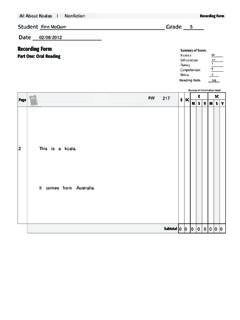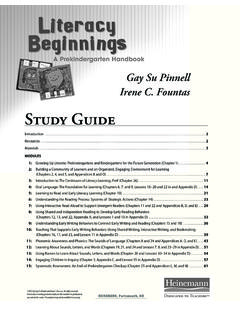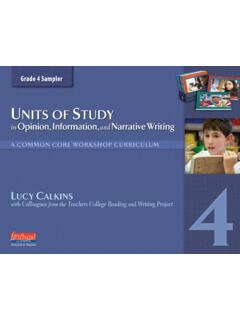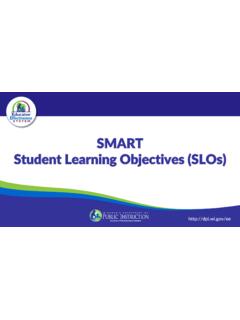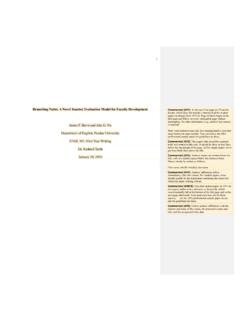Transcription of Reading Strategies - Heinemann
1 JENNIFER SERRAVALLOR eadingStrategiesKBookYOUR EVERYTHING GUIDE T O DEVELOPING SKILLED READERSWith 300 strategiesHEINEMANN Portsmouth, NHStudy GuideHeinemann 361 Hanover StreetPortsmouth, NH 03801 and agents throughout the world 2015 by Jennifer SerravalloAll rights reserved. No part of this guide may be reproduced in any form or by any electronic or mechanical means, including information storage and retrieval systems, without permission in writing from the publisher, except by a reviewer, who may quote brief passages in a review; and with the exception of reproducibles (identified by The Reading Strategies Book Study Guide copyright line), which may be photocopied for classroom use. Dedicated to Teachers is a trademark of Greenwood Publishing Group, author and publisher wish to thank those who have generously given permission to reprint borrowed material:Hierarchy of Possible Goals, Goals-Skills- Strategies , Six-Week Schedule, Prompting Readers, Gradual Release, Plot vs.
2 Theme, and Mistakes Can Lead to Lessons from The Reading Strategies Book by Jennifer Serravallo. Copyright 2015 by Jennifer Serravallo. Published by Heinemann , Portsmouth, NH. All rights from the Heinemann Digital Campus course Teaching Reading in Small Groups by Jennifer Serravallo. Copyright 2013 by Heinemann , Portsmouth, NH. All rights Your Week, Class Profile, and Independent Reading assessment forms from Independent Reading assessment : Fiction by Jennifer Serravallo. Copyright 2012 by Jennifer Serravallo. Published by Scholastic Inc. Reprinted by permission of the publisher. Previously reprinted with permission in Serravallo s The Literacy Teacher s Playbook, Grades K 2, and The Literacy Teacher s Playbook, Grades 3 6, published by 1.
3 How Do I Know What to Teach? 5 2. Revise Your Curriculum to be More Specific 7 3. Imagine the Course 8 4. Visualize It 10 5. From Page to Practice 12 6. Create a Toolkit 13 7. Mark Up a Demo Text 14 8. Revise Your Guided Reading Lessons to be More Explicit 15 9. Planning Prompts 16 10. Author New Strategies 18 11. Balancing Whole-Class and Individual Goals 19 12. Moving to a New Level 21 13. One Strategy, Many Twists 22 14. Plan a Curriculum of Talk 23 15. Plan a Curriculum of Writing About Reading 24 16. What Does Got It Look Like? 25 17. Studying Support 26 18. Teach, Review, Respond 2832 AppendicesLinks to student work samples 29 Planning Your Week form 30 Class Profile form 31A Curriculum of Talk form 32A Curriculum of Writing About Reading form 33 Guided Reading Planning Sheet 34 Bibliography 361An Introduction to the Study GuideI m so happy you ve chosen to study The Reading Strategies Book with colleagues!
4 Taking the opportunity to try out material in the book alongside other teachers and leaders in a school has the potential to help your practice grow exponentially. I ve put together this guide to jump-start collaboration by including ideas for how I might guide your practice if I were there with you. I ve included ideas in this guide that will work well in discussion groups or meetings, and others that will work well when you practice inside a classroom with students. If your schedule doesn t allow you to teach alongside another teacher while school is in session, you may also consider filming your teaching and sharing it during after-school hours. One note about this: opening up your classroom (literally or with transcripts and videos) might seem a little nerve-wracking at first, but doing so will provide endless opportuni-ties for thoughtful reflection and revision of best practices.
5 I highly recommend trying!For fun and easy reference, I decided to format this study guide like I do the Strategies in The Reading Strategies Book. Each collaboration suggestion has: A Title A Procedure: a clear, step-by-step process for the activity A Level: a marginal denotation as a beginner, intermediate, or advanced activity. Some are marked acceptable for any and there are notes within the page to understand how to adapt for teachers of differing experience levels. Book to Book: cross-references to my other books, for those of you who have them, to help you understand how my books fit togetherWelcome2 THE Reading Strategies BOOK Study Guide Setting: a suggestion for whether this works best at a teacher meeting (such as a PLC or faculty meeting) or while working in classrooms with children (such as a lab site) Coaching Tips.
6 A more in-depth discussion of how to do the activity with colleagues, as well as some sidebar notes I d likely tell you if I were there with you as you , you ll find an overview table of all eighteen suggestions at a hope you find this to be an easy-to-follow guide that offers ideas for conversations, activities, and practices that will not only strengthen your strategic Reading instruction, but will also strengthen collaboration with your colleagues. TitleLevelBook to BookSetting1 How Do I Know What to Teach?AnyEither of the PlaybooksMeeting room2 Revise Your Curriculum to be More SpecificAnyEither of the PlaybooksMeeting room3 Imagine the CourseAnyConferring with Readers or Teaching Reading in Small GroupsMeeting room4 Visualize ItAnyThe Reading Strategies BookMeeting room5 From Page to PracticeAnyConferring with Readers or Teaching Reading in Small GroupsClassroom6 Create a ToolkitAnyThe Reading Strategies BookMeeting room7 Mark Up a Demo TextAnyTeaching Reading in Small GroupsMeeting room8 Revise Your Guided Reading Lessons to be More ExplicitBeginner or IntermediateEither of the Playbooks and Teaching Reading in Small GroupsMeeting room9 Planning PromptsBeginner or IntermediateTeaching Reading
7 In Small Groups and The Reading Strategies BookMeeting room10 Author New StrategiesIntermediateTeaching Reading in Small GroupsMeeting room11 Balancing Whole-Class and Individual GoalsIntermediateTeaching Reading to Small Groups, either of the Playbooks, and Conferring with ReadersMeeting room12 Moving to a New LevelIntermediate or AdvancedEither of the Playbooks and Teaching Reading in Small GroupsMeeting room13 One Strategy, Many TwistsIntermediate or AdvancedConferring with Readers and Teaching Reading in Small GroupsClassroom14 Plan a Curriculum of TalkIntermediate or AdvancedTeaching Reading in Small Groups, either of the Playbooks, and Conferring with ReadersMeeting room15 Plan a Curriculum of Writing About ReadingIntermediate or Advanced Teaching Reading in Small Groups, either of the Playbooks, and Conferring with ReadersMeeting room16 What Does Got It Look Like?
8 Intermediate or AdvancedEither of the PlaybooksMeeting room17 Studying SupportAdvancedTeaching Reading in Small Groups or Conferring with ReadersClassroom18 Teach, Review, RespondAdvancedEither of the PlaybooksMeeting room3 THE Reading Strategies BOOK Study Guide14 THE Reading Strategies BOOK Study GuideDecoding, using Structure as a Source of InformationSKILLC hoose is when ..anymeeting roomLEVELSBOOK TO BOOKSETTINGSee Teaching Reading in Small Groups pages 117 121 for more discussion about when to choose demonstration as a method, and pages 114 116 to learn more about how to make demonstrations Find a rich text that you plan to read aloud to your class. One strategy at a time, mark up the text with possible places to demonstrate.
9 You may want to include notes about the strategy on the sticky note you use. Coaching Tips I learned from Carl Anderson many years ago that it s helpful to confer with a text under your arm (2000) so that when you need to give a quick example or demonstrate a strategy, the text is right there at your fingertips. This will save time since you won t need to run back to your desk or easel ledge to retrieve the book you wanted to make this text easy to use, I recommend Reading the text aloud to the class during an interactive read-aloud so the children are very familiar with it. That way, when you re in the midst of a conference or small group you ll be able to quickly turn to a page to ref-erence a small part, saving time in your Mark Up a Demo TextCoaching Tips: These are notes, coach to coach, that include helpful tips and more elaborated advice on how to engage in the professional learning activity.
10 At times, there is also advice for making the activity more simple or more sophisticated depending on the group of teachers who are : For quick reference, the procedure summarizes the steps involved in the professional learning Reading Strategies BOOK Study GuideDecoding, using Structure as a Source of InformationSKILLC hoose is when ..LEVELSBOOK TO BOOKSETTING meeting room only, or classroom plus meeting roomFor more information on what to expect of students at different levels (and how to interpret artifacts of student learning) see either of the Literacy Teacher s or advancedProcedure Find one strategy that would work for at least one student in each teacher s classroom in the study group. Go back to your respective classrooms and teach the strat-egy.
